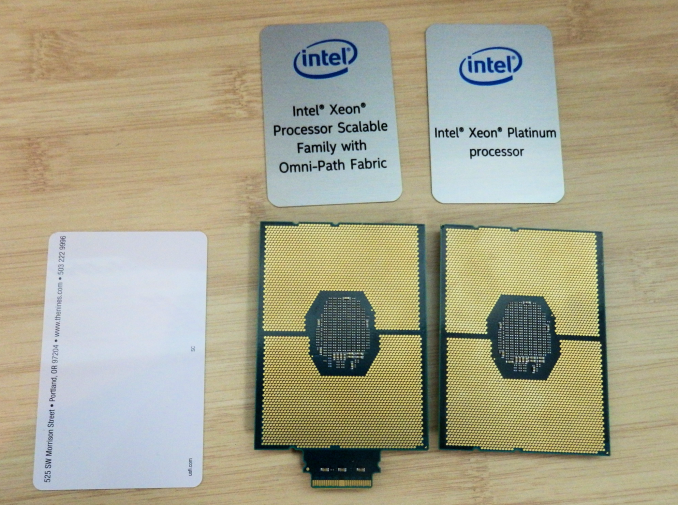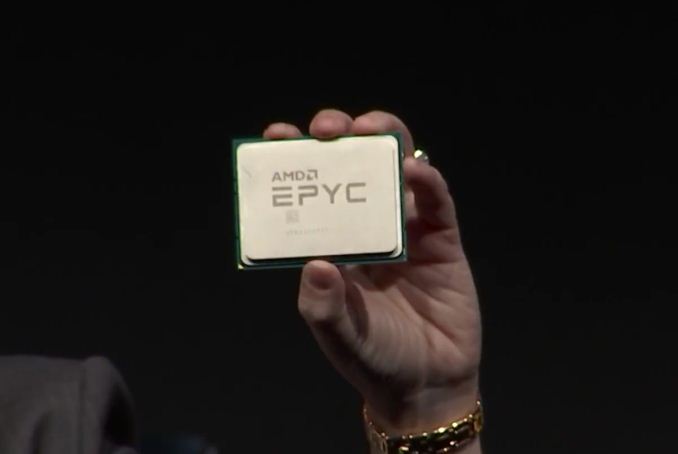Sizing Up Servers: Intel's Skylake-SP Xeon versus AMD's EPYC 7000 - The Server CPU Battle of the Decade?
by Johan De Gelas & Ian Cutress on July 11, 2017 12:15 PM EST- Posted in
- CPUs
- AMD
- Intel
- Xeon
- Enterprise
- Skylake
- Zen
- Naples
- Skylake-SP
- EPYC

This morning kicks off a very interesting time in the world of server-grade CPUs. Officially launching today is Intel's latest generation of Xeon processors, based on the "Skylake-SP" architecture. The heart of Intel's new Xeon Scalable Processor family, the "Purley" 100-series processors incorporate all of Intel's latest CPU and network fabric technology, not to mention a very large number of cores.
Meanwhile, a couple of weeks back AMD soft-launched their new EPYC 7000 series processors. Based on the company's Zen architecture and scaled up to server-grade I/O and core counts, EPYC represents an epic achievement for AMD, once again putting them into the running for competitive, high performance server CPUs after nearly half a decade gone. EPYC processors have begun shipping, and just in time for today's Xeon launch, we also have EPYC hardware in the lab to test.
Today's launch is a situation that neither company has been in for quite a while. Intel hasn't had serious competition in years, and AMD has't been able to compete. As a result, both companies are taking the other's actions very seriously.
In fact we could go on for much longer than our quip above in describing the rising tension at the headquarters of AMD and Intel. For the first time in 6 years (!), a credible alternative is available for the newly launched Xeon. Indeed, the new Xeon "Skylake-SP" is launching today, and the yardstick for it is not the previous Xeon (E5 version 4), but rather AMD's spanking new EPYC server CPU. Both CPUs are without a doubt very different: micro architecture, ISA extentions, memory subsystem, node topology... you name it. The end result is that once again we have the thrilling task of finding out how the processors compare and which applications their various trade-offs make sense.
The only similarity is that both server packages are huge. Above you see the two new Xeon packages –with and without an Omni-Path connector – both of which are as big as a keycard. And below you can see how one EPYC CPU fills the hand of AMD's CEO Dr. Lisa Su.
Both are 64 bit x86 CPUs, but that is where the similarities end. For those of you who have been reading Ian's articles closely, this is no surprise. The consumer-focused Skylake-X is the little brother of the newly launched Xeon "Purley", both of which are cut from the same cloth that is the Skylake-SP family. In a nutshell, the Skylake-SP family introduces the following new features:
- AVX-512 (Many different variants of the ISA extension are available)
- A 1 MB (instead of a 256 KB) L2-cache with a non-inclusive L3
- A mesh topology to connected the cores and L3-cache chunks together
Meanwhile AMD's latest EPYC Server CPU was launched a few weeks ago:
On the package are four silicon dies, each one containing the same 8-core silicon we saw in the AMD Ryzen processors. Each silicon die has two core complexes, each of four cores, and supports two memory channels, giving a total maximum of 32 cores and 8 memory channels on an EPYC processor. The dies are connected by AMD’s newest interconnect, the Infinity Fabric...
In the next pages, we will be discussing the impact of these architectural choices on server software.











219 Comments
View All Comments
ddriver - Tuesday, July 11, 2017 - link
Gotta love the "you don't care about the xeon prices" part thou. Now that intel don't have a performance advantage, and their product value at the high end is half that of amd, AT plays the "intel is the better brand" card. So expected...OZRN - Wednesday, July 12, 2017 - link
You need some perspective. Database licensing for Oracle happens per core, where Intel's performance is frequently better in a straight line and since they achieve it on lower core count it's actually better value for the use case. Higher per-CPU cost is not so much of a concern when you pay twice as much for a processor license to cover those cores.I'm an AMD fan and I made this account just for you, sweetheart, but don't blind yourself to the truth just because Intel has a history of shady business. In most regards this is a balanced review, and where it isn't, they tell you why it might not be. Chill out.
ddriver - Thursday, July 13, 2017 - link
You are such a clown. Nobody, I repeat, NOBODY on this planet uses 64 core 128 thread 512 gigabytes of ram servers to run a few MB worth of database. You telling me to get pespective thus can mean only two things, that you are a buthurt intel fanboy troll or that you are in serious need of head examination. Or maybe even both. At any rate, that perfectly explains your ridiculously low standards for "balanced review".Notmyusualid - Friday, July 14, 2017 - link
It seems no matter what opinion someone presents that might exhibit Intel in a better light - you are going to hate it anyway.What a life you must lead.
OZRN - Friday, July 14, 2017 - link
No, they don't. They use them to host gigabytes to terabytes worth of mission critical databases, with specified amounts of cores dedicated to seperate environments of hard partitioned data manipulation. I've done some quick math for you and in an average setup of Enterprise Edition of Oracle DB, with only the usually reported options and extras, this type of database would cost over $3.7m to run on *64 cores alone*. At this point, where is your hardware sunk costs argument?Also, I don't think anyone here is impressed by your ability to immediately personally insult people making valid points. Good luck finding your head that deep in your colon.
CajunArson - Tuesday, July 11, 2017 - link
"All of our testing was conducted on Ubuntu Server "Xenial" 16.04.2 LTS (Linux kernel 4.4.0 64 bit). The compiler that ships with this distribution is GCC 5.4.0."I'd recommend using a more updated distro and especially a more up to date compiler (GCC 5.4 is only a bug-fix release of a compiler from *2015*) if you want to see what these parts are truly capable of.
Phoronix does heavy-duty Linux reviews and got some major performance boosts on the i9 7900X simply by using up to date distros: http://www.phoronix.com/scan.php?page=article&...
Considering that Purley is just an upscaled version of the i9 7900X, I wouldn't be surprised to see different results.
CajunArson - Tuesday, July 11, 2017 - link
As a followup to my earlier comment, that Phoronix story, for example, shows a speedup factor of almost 5X on the C-ray benchmark simply by using a modern distro with some tuning for the more modern Skylake architecture.I'm not saying Purley would have a 5X speedup on C-ray per-say, but I'd be shocked if it didn't get a good boost using modern software that's actually designed for the Skylake architecture.
CoachAub - Wednesday, July 12, 2017 - link
Keywords: "actually designed for the Skylake architecture". Will there be optimizations for AMD Epyc chips?mkozakewich - Friday, July 14, 2017 - link
If it's a reasonable optimization, it makes sense to include it in the benchmark. If I were building these systems, I'd want to see benchmarks that resembled as closely as possible my company's workflow. (Which may be for older software or newer software; neither are inherently more relevant, though benchmarks on newer software will usually be relevant further into the future.)CajunArson - Tuesday, July 11, 2017 - link
And another followup: The time kernel compilation on the i9 7900X got almost a factor of 2 speedup over the Ubuntu 16.04 using more modern distros.